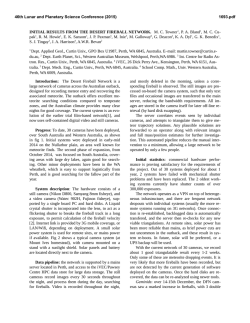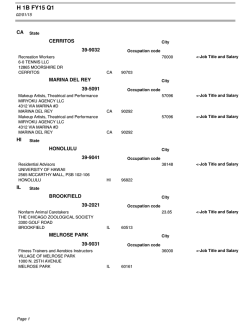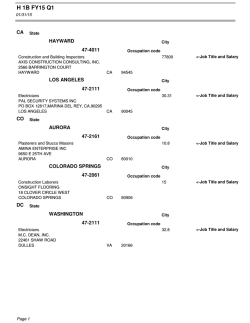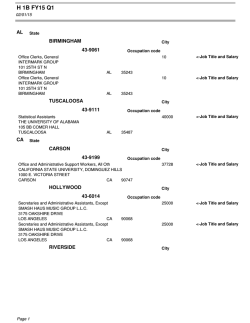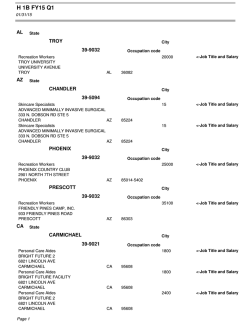
Skilled Occupation List (SOL) 2015-16
Skilled Occupation List (SOL) 2015-16 Tracking Code: G48DAF Name Individual * Jason O'Dwyer Organisation Master Electricians Australia What are the industry/industries and ANZSCO occupation/s that you or your organisation represents for the purposes of this submission? Industry Electricity Construction Occupation The three dropdowns below accord with the ABS ANZSCO classification of occupations. Selections are required at the ‘Occupation Group’ 2-digit level and at the ‘Occupation Unit (4-digit)’ level, but can also be made down to the Occupation (6-digit) level depending on the occupation/s to which your submission relates. Additional occupations can be selected by way of the ‘Add item’ button. For each occupation selected, please indicate whether your advice is to Include, Exclude, or is Neutral (other) with respect to the 2015-16 SOL. The rest of the form can be used to provide evidence/reasons to support your recommendations. Attachments can also be added after clicking the 'Submit' button. Page 1 of 6 Item 1 Occupation Group * Electrotechnology and Telecommunications Trades Workers Occupation Unit * All Occupation Summary advice for 2015-16 SOL * Include Exclude Neutral Are there any occupations that you represent where there is evidence of imbalances in the demand for and supply of skills in the medium-to-long term? * According to a report from DEEWR, Australian Jobs 2014, Electrician is listed in the top 10 occupations expected to provide the largest number of new jobs over the next 5 years. Electrician’s future employment change in the next 5 years is projected to be between 8.5% and 12% with future job openings to be over 50,000. Job Outlook confirms this data, forecasting that employment for electricians to November 2018 is expected to grow strongly from 145,400 to a projected 161,000. The DEEWR report also indicates that Apprentices or trainees in a trade occupation (for example, Electrician, Carpenter or Plumber) have very stronger outcomes, with 92.3% employed. According to Job Outlook, for electricians specifically, the unemployment rate is below average. Data from the National Centre for Vocational Education Research (NCVER) does indicate a marginal increase in completion rates for electrical apprentices from 5,219 in 2013 to 5,595 in 2014. However, this rate is still a significant drop from the completion figure of 6,790 in 2012. It is also important to note that cancellation/withdrawal rates have risen from 5,152 in 2013 to 5,510 in 2014. Commencements have also dropped from 8,178 in 2013 to 7,397 in 2014. Given the projected employment change over the next 5 years of between 8.5% and 12% for electricians and the currently high employment rates in trade occupation rates in general there is clear evidence that there will continue to be skills shortages for electricians in the medium to long term. Page 2 of 6 The E-Oz Enviroscan 2013 observed continued reporting of skills shortages by industry participants. The E-Oz report also predicts that electrical apprentice completions will peak in 2014 and then fall away, driving medium term deterioration in skills supply. Another report from NCVER, Tradespeople for the resources sector: Projections 2010-2020, provides projections on expected employment growth to 2020 for specific trade occupations. The paper canvasses the best, worst and average case scenarios for each occupation based on historical apprenticeship commencement rates to population projections, incorporating assumptions about attrition. According to this report, in the average scenario, the workforce for electricians is expected to grow by close to 46,000 by 2020 increasing from 132,200 in 2010 to 178,150 in 2020. In contrast, the worst case scenario would see 5,915 fewer electricians employed in the sector in 2020 than there were in 2010. While there are notable differences between the average and worst case scenarios, it is certainly an indication of the potential critical under supply of electricians that could be facing the Australian economy out to 2020. Is there evidence of imbalances in the demand for and supply of skills in the medium-to-long term in non-metropolitan areas? If so, can you indicate in what part of Australia and the number in the occupation in over or undersupply. While the skilled shortages in regional areas for electricians appear to have eased to a certain extent, employers are still experiencing difficulty in filling vacancies. This is particularly evident in regional areas of Queensland and Western Australia. Are there any occupations which require formal licensing or registration arrangements in order to practice/perform in this occupation? For example: • Midwives are required to register with the nurses board in their state or territory • Panelbeaters are required to be registered or certified with the state Motor Vehicle Repair Industry Authority Currently each state and territory in Australia has separate licensing arrangements for persons working in electrical occupations. The following electrical occupations represented by Master Electricians Australia require an electrical licence to be issued by the relevant state or territory electrical regulatory body: Electrician (General) Page 3 of 6 Electrician (Special Class) Lift Mechanic Electrical Linesworker Technical Cable Joiner Electronic Equipment Tradesworker Electronic Equipment Tradesworker (General) Electronic Equipment Tradesworker (Special Class) There are also various classes of restricted and/or higher level licences applicable for these occupations in various state/territory jurisdictions. Refrigeration and air-conditioning mechanics are subject to some jurisdictional licensing which differs amongst the states and territories. There is also a national licensing arrangement requiring any person who handles refrigerant or works on refrigeration and air-conditioning equipment to hold a Refrigerant Handling Licence, issued by the Australian Refrigeration Council. Is it expected that your employment sector will be impacted by any medium-to-long term trends which will impact upon demand and/or supply (excluding costs associated with training, labour hire, and international sponsorship)? Please provide evidence (e.g. data source, policy document) which substantiates these claims. For example: • New benchmarks for childcare centres mandate increased staff-to-child ratios and higher qualification standards for childcare workers. HIGH SPEED BROADBAND While the National Broadband Network (NBN) is no longer going ahead, there has been a commitment from the new Federal Government to introduce high-speed broadband through a fibre-to-the-node system. This system involves running fast fibre-to-nodes at the end of streets throughout Australia, with the last mile between the nodes to be covered by the existing copper network. While process may not be as involved as the NBN, it will undoubtedly add to the demand for skilled electrical workers across the country. As well as the physical roll out of fibre-to-the-node, there will be demand on the customer premises side of high-speed broadband. Skilled electrical and communications workers will be required to assist customers with installation of digital televisions, home security systems and forms of interactive entertainment. RENEWABLE ENERGIES TECHNOLOGY Page 4 of 6 Despite the new Federal Government’s repeal of the carbon tax, escalating electricity prices remain a reality for the Australian public. This creates a strong incentive for consumers to actively consider their energy consumption decisions and look for more energy efficient alternatives. Renewable energy options are likely to continue to be in high demand from large businesses to individual householders. In fact, this demand can already be seen with the growing popularity of solar photovoltaic (PV) panels. According to a report from the Bureau of Resources and Energy Economic, Energy in Australia 2013, between 2010 and 2011 there was a 150 per cent increase in installed PV capacity in Australia. Supportive government policy in the form of various rebates and tariffs, in combination with the rapid expansion in the global production of PV modules has contributed to dramatic reductions in the price of PV units, making PV technology a more cost competitive option when compared to the fossil fuel-fired alternatives. ENERGY AUDITING With the increasing public consciousness of their carbon footprint from both an environmental and financial perspective, there is also a growing demand from both householders and business for the services of an energy auditor. The skills of a qualified electrician may also be required to implement some of the strategies recommended by an energy auditor, which may include solar PV. SMART METER ROLL-OUT While an Australia-wide mandatory roll-out of smart meters is not planned for the immediate future, it is likely that the cost of electricity will see an increasing number of consumers requesting the installation of smart meters to help monitor and manage their energy use. In 2012, the Standing Council on Energy and Resources (SCER) released a series of recommendations in response to the Power of Choice Review. These recommendations included commitment to a market driven roll-out of smart meters and other advanced metering. Please provide any other information you consider relevant evidence to support your submission For example, you may know of some independent studies about your occupation that supports your advice to us. NCVER, Apprentice and trainee data tables March quarter 2014 Department of Employment, "Australian Jobs 2014" Department of Resources, Energy and Tourism, "Energy in Australia", May 2013 Page 5 of 6 Energy Skills Australia, "Enviroscan 2014" Job Outlook, Electricians (ANSZSCO: 3411), 2014 Would you like to make any additional comments on the SOL? Please provide the name, position and contact details of a person within your organisation who is willing to be contacted if any further information or follow-up is required. Name * Kelly Dove Position * Senior Policy Advisor Contact details * Email: [email protected] Ph: 1300 889 198 All information, including name and address details, contained in submissions will be made available to the public on the Department of Industry website unless you indicate that you would like all or part of your submission to remain in confidence. Automatically generated confidentiality statements in emails do not suffice for this purpose. Respondents who would like all or part of their submission to remain in confidence should provide this information in an email to SOL@industry. gov.au . Legal requirements, such as those imposed by the Freedom of Information Act 1982, may affect the confidentiality of your submission. Page 6 of 6
© Copyright 2025











